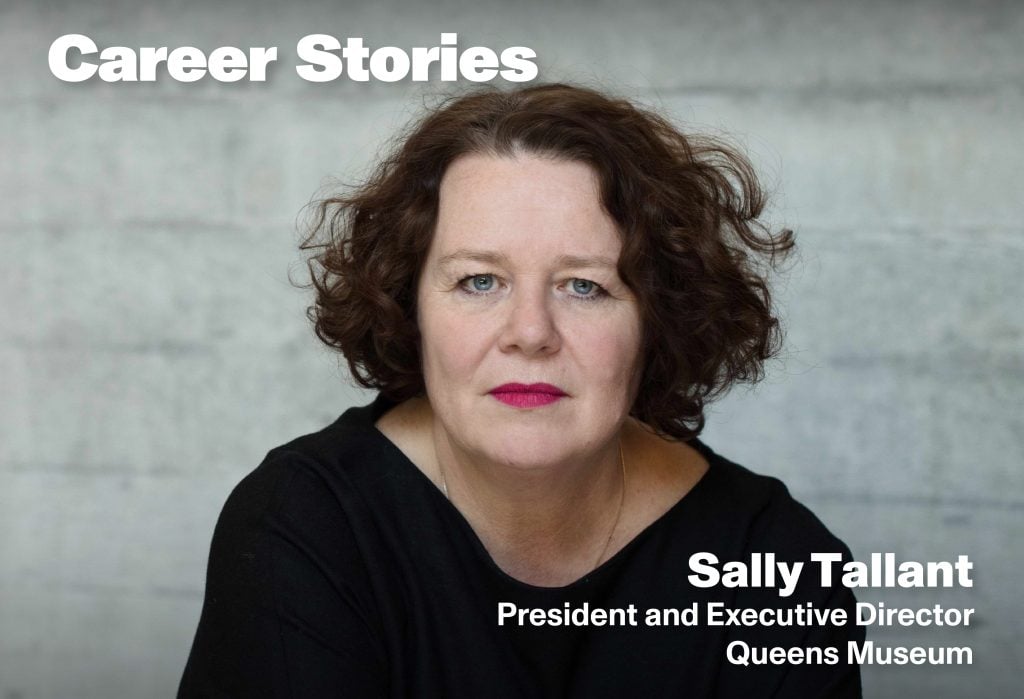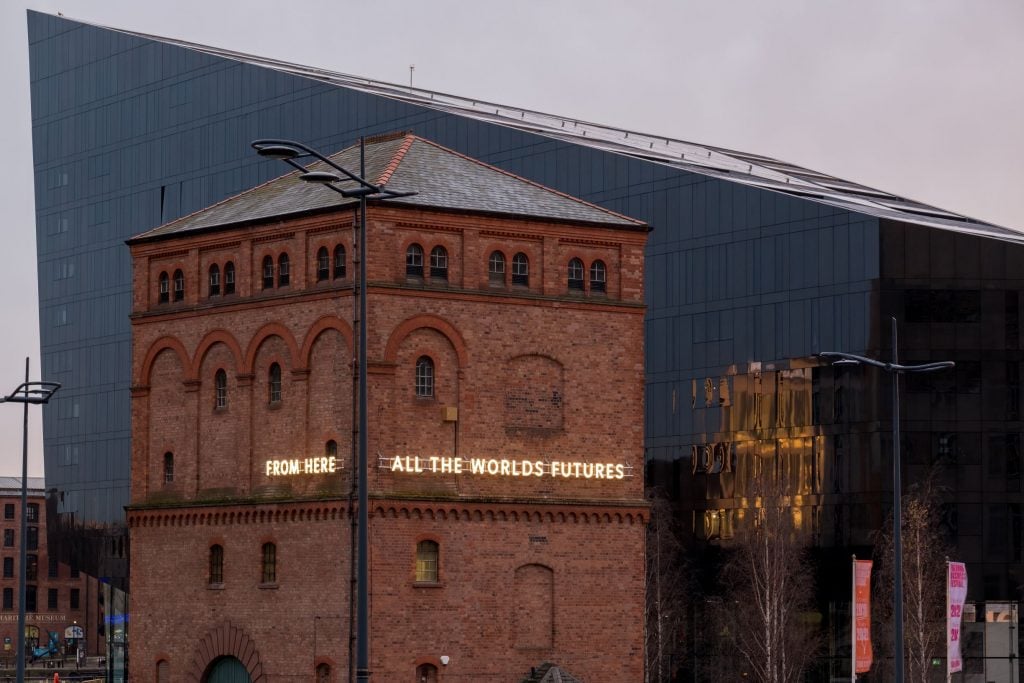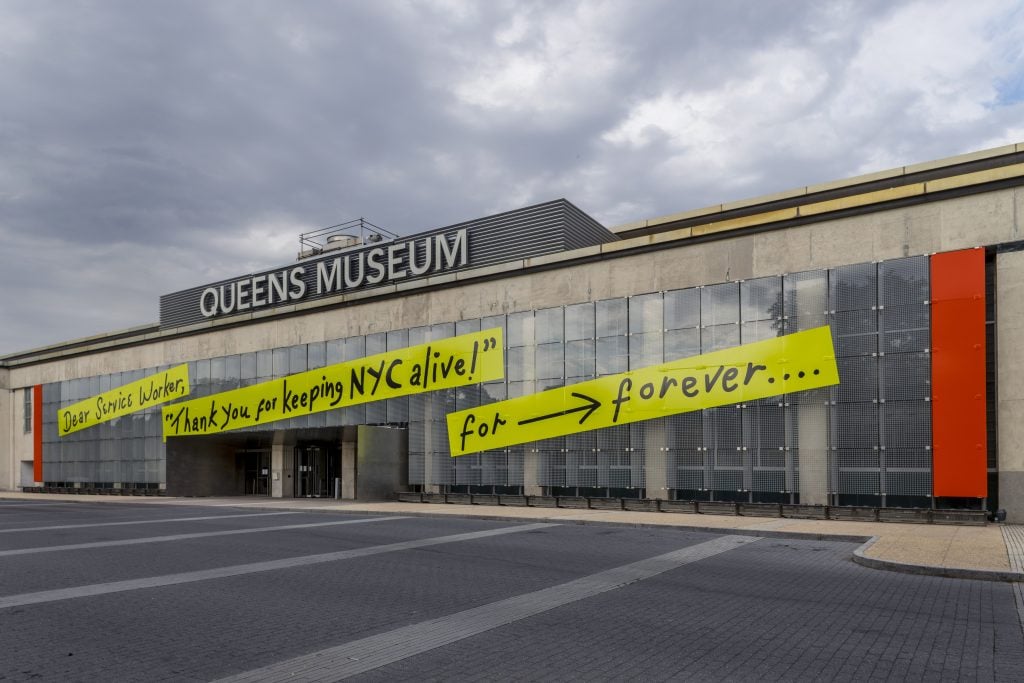Career Stories
Queens Museum Executive Director Sally Tallant on Her Vision for a More Just Art World
Tallant shares how she went from artist to head of a major art institution.

Tallant shares how she went from artist to head of a major art institution.

Samantha Baldwin

Before she was the president and executive director of the Queens Museum, Sally Tallant was an artist. Over the course of her decade-long practice, Tallant became acutely aware of the barriers that make art institutions inaccessible to individuals who have been systemically excluded on the basis of class, race, gender, disability, or sexuality. Understanding a need for a swift and drastic change, she became an educator, organizer, and curator.
Since then, Tallant has dedicated her career to making the art world a more inclusive and accessible place during leadership roles at the Serpentine Gallery in London, the Liverpool Biennial, and now, the Queens Museum.
Read on to learn more about her inspiration, goals for the museum world, and the best advice she ever received.

Nathan Coley, From Here (2020). St George’s Dock Pumping Station, Mann Island, Liverpool. ©Photography by Mark McNulty.
At what point did you decide that you wanted a career in the art world and why?
I don’t remember ever wanting to do anything else. I never imagined that I would have a career at all, but I went to art school to make art and I thought I would become an artist, which I did for almost a decade. Over the years I became an educator, organizer, and curator out of necessity as I realized that so much needed to change in terms of who could become an artist and whose work, culture, and what kind of practices were valued and included in galleries and museums. I have spent my time so far working to create accessible and inclusive structures and organizations that try to remove barriers, whether they are cultural, educational, financial, or physical. I know from my own experience that art is essential and at the heart of transformation and I want to be a part of making sure art and arts institutions are relevant and accessible to everyone, especially those who have been historically and systemically excluded because of class, race, gender, disability, and sexuality.
You served as head of programs at the Serpentine Gallery for over 10 years. What’s the greatest lesson that you learned in this position?
I learned that “change is a process, not an event.” This is a quote from Lucy Lippard. I learned that people are valuable and that we are capable of anything if we are part of a great team. Over the 10 years that I worked at the Serpentine we did amazing things. I managed an integrated programs team of curators, educators, and organizers and we delivered exhibitions, public programs, ambitious durational projects with the community and long-term education projects. This integrated way of working removed traditional silos and encouraged collaboration and deeper understanding of skills across strands and departments. It was exciting to really experience an organization centering artists, communities and learning and we really did see what was possible in terms of working together in a truly collaborative way.
You were appointed artistic director and CEO of the Liverpool Biennial in 2011. What is your proudest achievement from your time in this role?
Liverpool Biennial is the largest visual arts project in the U.K. and it was a great privilege to have the opportunity to lead the organization for eight years and to deliver four editions of the biennial with so many amazing partners in the city and internationally. While I was there I developed a “perennial model” of a biennial, operating year round to accumulate content and embed as part of the hyper-local arts ecology. I am proud of all of the work that we did and the amazing commissions and incredible artists I had the chance to work with. Most of all I am proud of the team and partnerships that I was able to develop and the opportunities that we created for artists locally, nationally, and internationally. We made over 150 new works including many permanent commissions in the city.
You were recently appointed president and executive director of the Queens Museum. What are your goals and visions for its future?
I joined the Queens Museum in 2019. I am inspired by the history of the building, which hosted two World’s Fairs and the U.N. General Assembly from 1947 to 1950. It is located in Queens, which is such an inspiring place to be and benefits from being the most diverse place in the U.S., with over 160 languages being spoken. Before coming to Queens Museum I was following the work of previous directors closely including Janet Schneider, Tom Finklepearl, and Laura Racovich. The museum has always been rooted in its communities and felt like a place where my experience and values could resonate and grow. We are building a museum that prioritizes artists who are leading and engaging in conversations about social, racial, environmental, disability, language and climate justice, critical pedagogy, and the value of art. We are working with artists that can connect to our hyper-local, international communities.
We are currently in the middle of the “Year of Uncertainty,” which brings artists, community partners, and co-thinkers together with the team to reimagine the museum. It is exciting to see how we can make a museum that is defined by and through conversations with our neighbors, communities and constituents. To honor the history that UNICEF was founded in the building when we hosted the U.N., we are developing a multi-lingual, intergenerational family learning center, a Queens Children’s Museum as part of our capital program to complete the renovation of the building and this is very, very exciting!

Mierle Laderman Ukeles, For⟶forever… (2020). Photo ©Mierle Laderman Ukeles by Hai Zhang/the Queens Museum.
What is a typical day like as the executive director?
I have a lot of meetings! I start early so I can have calls with people internationally, including family who are mostly in the U.K. I am at the Queens Museum most days and enjoy being there with the team and visitors. I meet with the team and a wide range of artists, educators, colleagues, and peers as well as the many stakeholders and constituents that we work with to understand what our audiences need from us and also how we can create content that is timely and relevant. Now that New York is opening its doors again I am out at openings most evenings seeing amazing exhibitions and meeting friends and colleagues.
What is the greatest challenge you have faced throughout your career?
Finding ways to make the things I want to do possible. Creating the conditions includes building community, raising awareness, raising money, and support and persuading people in power to remove barriers and make things possible. I never seem to have enough time to write and reflect. I hope that I can manage to do this in the near future when I am not in the midst of organizing all the time.
What inspires you? How do you stay motivated?
I am always excited and motivated by working with artists and educators. I have been lucky that all of the opportunities I’ve had have offered me growth and the chance to learn. I try to create a working environment that is also a learning environment for the team as well as the public. I know that working to ensure that art is part of everyone’s life, regardless of where they live and what background they come from is important, and working towards a more inclusive and equitable environment keeps me motivated every day.
Do you have a mentor? What is the best piece of advice they ever gave to you?
I have a wide network of many mentors. There are so many people who have supported me from the beginning and I am grateful to them all for their wisdom and care. In the 90s I used to program performance and remember that the artists and teachers Susan Hiller, Tina Keane and Monica Ross came to nearly all of them even when there were only a few people there. They encouraged me and gave me hope and ambition. So many amazing teachers and feminist curators and artists have created space for me and given me time and I try to do that for people as they enter the sector. When I moved to New York I was welcomed by so many of my colleagues and it has been amazing to see and experience the support of such a connected cultural community.
What is advice you would give your younger self at the start of your career?
Don’t be afraid to challenge structures that exclude you. Take your time, listen and understand before you try to change things. Don’t put off having a child if you want to, you can choose to have your career and a family. I didn’t manage to and wish that it had been more acceptable for women to talk about this in the workplace. As a director I try to support people (women and men) to be able to become parents and offer the paid parental leave and the flexibility they need.
What is the best piece of advice you have ever received?
The best advice I have been given is: Treat people as you would want to be treated. Don’t try to change everything at once. Know when to leave and remember you are not your job. It is what you chose to do. Remember that your interns will become your boss before you know it.